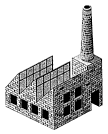The Industrial Manufacturing Production Index (IPI) registered a 6.3% rise in January, compared to the same month in 2022, while construction activity advanced 2.6% in the same period, INDEC reported yesterday.
During January, the industry seasonally adjusted series index showed a positive variation of 0.7% compared to December. Meanwhile, the synthetic indicator of construction activity (ISAC) marked a rise, a positive variation of 4.3% compared to the previous month, the agency detailed.
In this way, both indicators interrupted the falls that they had recorded in recent months in the seasonally adjusted series (in the comparison against the previous month).
In the first month of the year, fourteen of the sixteen divisions of the manufacturing industry presented year-on-year increases, led by “Food and beverages”, 9.1%; “Basic metal industries”, 8.9%; “Automotive vehicles, bodies, trailers and auto parts”, 24.8%.
With smaller increases were located “Metal products”, 15.2%; “Rubber and plastic products”, 10.3%; “Clothing, leather and footwear”, 12.0%; “Non-metallic mineral products”, 7.3%; “Oil refining, coke and nuclear fuel”, 8.3%; “Furniture and mattresses, and other manufacturing industries”, 10.5%; “Machinery and equipment”, 6.1%; “Textile products”, 5.8%; “Tobacco products”, 5.4%; “Wood, paper, publishing and printing”, 0.1%; and “Other equipment, apparatus and instruments”, 0.3%.
At the other extreme, the divisions of “Chemical substances and products” showed decreases, 4.5%; and “Other transport equipment”, 3.3%.
In the case of the apparent consumption of construction inputs in January 2023, the largest increases, in relation to the same month of the previous year, were registered in finished concrete, 26.3%; in the rest of the inputs (includes faucets, seamless steel tubes and glass for construction), 15.8%; and plaster, 11.4%.
There were also increases in plasterboard, 10.9%; granite and calcareous mosaics, 10.4%; portland cement, 9.2%; asphalt, 7.9%; construction paints, 5%; and in round iron and steel for construction, 2.7%. Meanwhile, decreases of 26% are observed in floors and ceramic coverings; 20.8% in ceramic sanitary ware; 13.5% in hollow bricks; and 8.7% in limes.
projections
Regarding what may happen to the industry in 2023, the LCG consultancy pointed out: “With a severe drought that is estimated to subtract around US$8,000 million from exports, together with net debt payments (US$3 billion with the IMF, for example), we hope that regulations on access to imported inputs will be maintained and/or deepened. Therefore, we project marginal growth compared to that observed during 2022, around 0.3% average”.
Meanwhile, for construction, the consultancy indicated: “By 2023 we expect it to maintain a growth path, although somewhat leaner than that exhibited during 2022 (activity ceiling). Being a sector characterized by high informality, together with a significant correlation with the exchange rate gap that lowers costs, we expect both factors to operate as a buffer for the coming year”.
Source: Ambito




